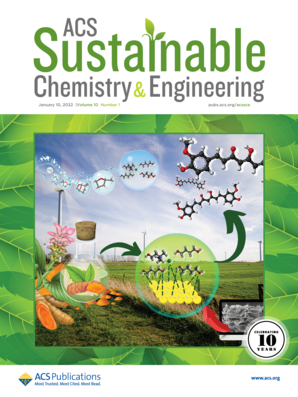UVC-Driven Postphotopolymerization: An Advanced Strategy for Reducing Residual Monomers in Waterborne Polymer Dispersions
IF 7.1
1区 化学
Q1 CHEMISTRY, MULTIDISCIPLINARY
引用次数: 0
Abstract
Waterborne polymer dispersions (latexes) are considered environmentally friendly and sustainable, yet they still contain residual monomers, raising significant health and environmental concerns. Reducing or eliminating residual monomers is critical for enhancing product sustainability. This study investigates a novel approach using short wavelength ultraviolet light (UVC, 250 nm) in a continuous tubular reactor to induce initiator-free postpolymerization of residual monomers in polymer latex. Key parameters such as residence time (0–30 min), type of purging gas (air or nitrogen), and monomer concentrations (400–7000 ppm) were explored. Results revealed that postphotopolymerization predominantly occurred in the aqueous phase and that there is a monomer diffusion limitation to full conversion, due to lack of agitation in a reactor under laminar flow of the latex. Adding Texanol, a high-boiling-point plasticizer, improved monomer partitioning between phases, achieving up to a 95% reduction of monomer concentration. EPR analysis showed that UVC irradiation generated OH* and OOH* radicals in the aqueous phase that initiate the polymerization. Despite prolonged irradiation, latex stability, molecular weights, and film mechanical properties remained unaffected. However, they present decreased water resistance, likely due to the newly created oligomers containing hydrophilic initiating moieties. This study highlights UVC irradiation in a tubular reactor as a promising technique for residual monomer removal while providing deeper insights into UVC-induced radical generation in emulsion photopolymerization without the use of initiators.

uvc驱动后光聚合:一种减少水性聚合物分散体中残留单体的先进策略
水性聚合物分散体(乳胶)被认为是环保和可持续的,但它们仍然含有残留的单体,引起了重大的健康和环境问题。减少或消除残留单体是提高产品可持续性的关键。本研究研究了一种利用短波紫外光(UVC, 250 nm)在连续管式反应器中诱导聚合物乳胶中残留单体无引发剂后聚合的新方法。考察了停留时间(0-30分钟)、净化气体类型(空气或氮气)和单体浓度(400-7000 ppm)等关键参数。结果表明,光后聚合主要发生在水相中,由于乳液在层流下的反应器中缺乏搅拌,单体扩散限制了完全转化。添加Texanol(一种高沸点增塑剂)改善了相之间的单体分配,单体浓度降低了95%。EPR分析表明,UVC辐照在水相中产生OH*和OOH*自由基,引发聚合反应。尽管长时间辐照,乳胶的稳定性、分子量和膜的机械性能没有受到影响。然而,它们表现出降低的水阻力,可能是由于新创建的低聚物含有亲水起始部分。本研究强调了在管式反应器中UVC照射作为去除残余单体的一种有前途的技术,同时为不使用引发剂的乳液光聚合中UVC诱导自由基的产生提供了更深入的见解。
本文章由计算机程序翻译,如有差异,请以英文原文为准。
求助全文
约1分钟内获得全文
求助全文
来源期刊

ACS Sustainable Chemistry & Engineering
CHEMISTRY, MULTIDISCIPLINARY-ENGINEERING, CHEMICAL
CiteScore
13.80
自引率
4.80%
发文量
1470
审稿时长
1.7 months
期刊介绍:
ACS Sustainable Chemistry & Engineering is a prestigious weekly peer-reviewed scientific journal published by the American Chemical Society. Dedicated to advancing the principles of green chemistry and green engineering, it covers a wide array of research topics including green chemistry, green engineering, biomass, alternative energy, and life cycle assessment.
The journal welcomes submissions in various formats, including Letters, Articles, Features, and Perspectives (Reviews), that address the challenges of sustainability in the chemical enterprise and contribute to the advancement of sustainable practices. Join us in shaping the future of sustainable chemistry and engineering.
 求助内容:
求助内容: 应助结果提醒方式:
应助结果提醒方式:


